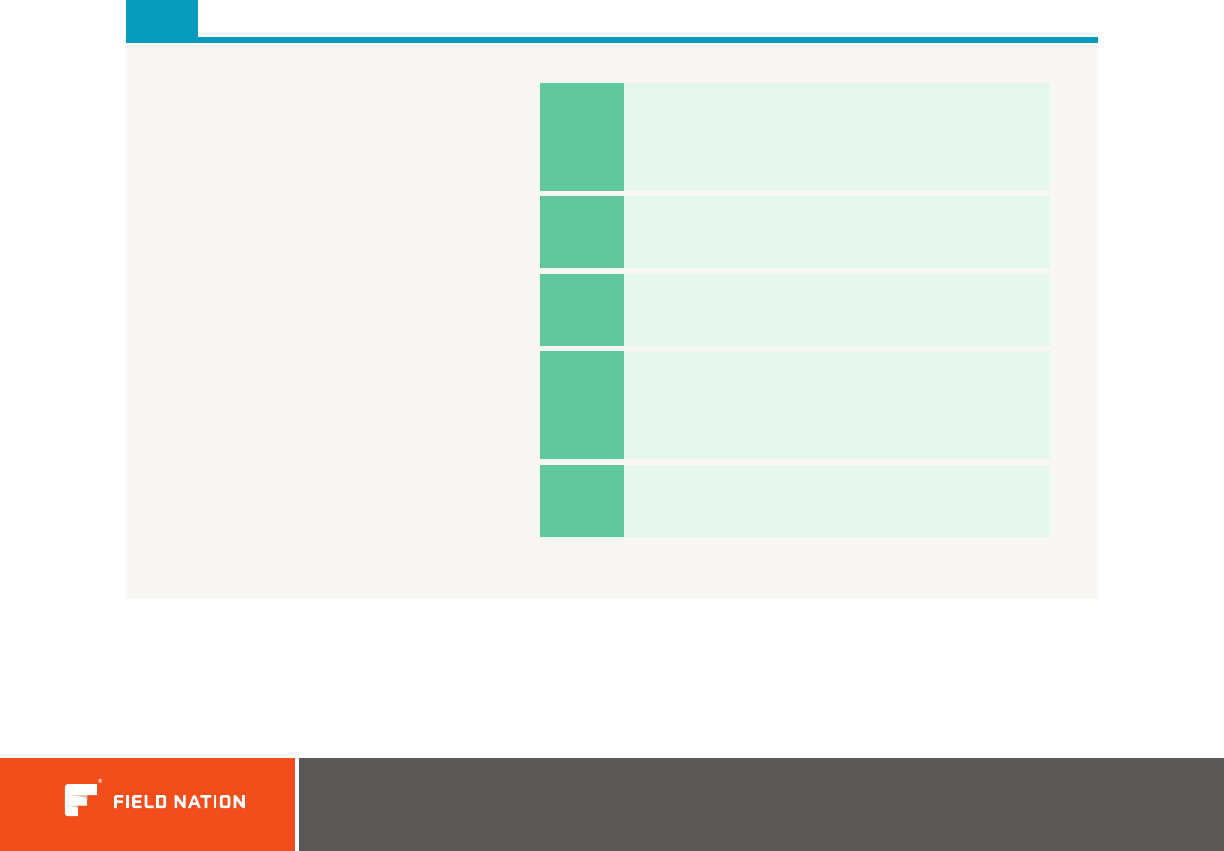
Whitepaper eldnation.com
Independent
Contractor
Workers’
Compensation
THE
AND

Workers’ Compensation and the Independent Contractor • 2eldnation.com
Introduction
In today’s gig economy individual workers seek to maximize their income and manage
their own careers. This trend is expected to grow well into the future. Companies that
want to compete need to shift and embrace these workers and the special regulations
that govern them.
This whitepaper dives into the world of workers’ compensation from its inception to
the present day with a focus on how independent contractors t into the workers’
compensation scheme.
What’s Workers’ Compensation?
Traditional workers’ compensation provides medical and
wage replacement benets for injured employees. When
an employee is injured in the course of employment,
they are generally covered by an employer’s workers’
compensation insurance subject to a few exceptions. If
the injured worker is not an employee but an independent
contractor, traditional workers’ compensation may not
apply unless the contractor purchased their own workers’
compensation insurance.
History & Purpose of Workers’ Compensation
Prior to the enactment of workers’ compensation,
employees were forced to sue their employer for
negligence to collect damages. The negligence standard
is a high bar for an employee to prove, so the process
was ineective. Many employees could not win their
cases and ended up relying on state social security and
unemployment benets to get by. As a result, states
began passing workers’ compensation legislation
throughout the 20
th
century to create a balance
between worker and employer rights.

Workers’ Compensation and the Independent Contractor • 3eldnation.com
Wisconsin passed the rst comprehensive workers’
compensation law in 1911, while Mississippi was the
last state in 1948. These early laws require employers
to provide medical and wage replacement benets for
injured on-the-job workers. If the injured employee
accepted these benets, they forfeit their right to sue
the employer – what is referred to as an “exclusive
remedy.” In other words, an injured worker who seeks
workers’ compensation gives up their right to recover
tort damages for negligence or other claims for a
“lesser” recovery of workers’ compensation.
Basic Workers’ Compensation Requirements
In the majority of states, coverage under the workers
compensation statute is required for private and public
employments. Each state enacts their own statutes, rules
and regulations, and vary on what thresholds of coverage
are required. States also oer exceptions to workers’
compensation. Many states provide exceptions for sole
proprietors–people who own their own business– or
casual employees such as seasonal workers.
There are two ways to ensure workers’ compensation is
administered–by private insurance or collective funding.
Most states allow for private insurance while some states/
jurisdictions are monopolistic fund states such as North
Dakota, Ohio, Washington, Wyoming, Puerto Rico, and
the U.S. Virgin Islands. In these jurisdictions, the states’
administers exclusively fund the workers’ compensation
program. To determine what each state requires, look to
each state’s statutes.
Workers’ Compensation and
the Gig Economy
Workers’ compensation functioned as planned when a
conventional employer-employee relationship existed.
But, the 21st century brought about a new relationship
for workers. Technology created a new type of on-
demand workforce - what industry experts call the
gig economy.
Instead of traditional nine-to-ve jobs, workers began
turning to software platforms to nd well-paying jobs
that provide the worker with exibility. Companies retain
a worker to do a one-time assignment or task instead of
hiring a W2 employee. This helps companies reduce costs
and allows workers to pick up work when and where they
need it.
Companies nd that the gig economy is more ecient
and helps reduce operating costs associated with full-
time employees. As a result, there are a growing number
of workers who are not participating in the traditional
workers’ compensation system. This is partly due to many
workers no longer qualifying as an “employee” under state
statutes, so they are not covered by a company’s workers’
compensation requirements.
Relationship of Gig Workers and Independent
Contractors with Workers’ Compensation
To avoid buying workers’ compensation coverage, some
companies - especially in high risk occupations - sought
to retain independent contractors to avoid paying the
high workers’ compensation rates. This practice became
pervasive within the long haul trucking industry.
Most states allow sole proprietors to “opt out” of the
workers’ compensation system. Some trucking rms
allowed (encouraged) their drivers to declare themselves
“independent contractors” and opt out of the workers’
compensation system. The drivers would lease the
tractor from the trucking company who would arrange
for each load, instruct the driver where to go and when,
and contract them to the trucking company on a full time
basis. By using independent contractors the trucking
rms reduced their personnel costs by 20% (the workers’
compensation rate). The independent contractor driver
would receive slightly higher pay and everyone was
happy...until a driver had a claim.

Workers’ Compensation and the Independent Contractor • 4eldnation.com
As an employee of the trucking rm, the driver would have
received workers’ compensation benets including wage
replacement and medical costs. But by opting out, the
driver commonly had no wage replacement and relied upon
their personal health insurance plan for medical costs. If
the driver was providential, the accident was caused by a
third party, who had adequate automobile liability and the
driver could recover/sue for damages. The problem was that
it often took years for a lawsuit to be concluded, meanwhile
the driver would le bankruptcy and end up relying upon the
social welfare safety net programs of the state.
The second problem was that after an injury the
independent contractor would attempt to renounce
their independent contractor status and assert
employee standing if they did not have medical and
disability insurance. In addition to the contractor or
the contractor’s family, the assertion may come from
third parties subrogated to the workers’ compensation
benets such as health insurers, governmental entities
who fund the social safety net. These risks were likely not
contemplated by the organization that contracted with
the independent contractor.
States soon took action to avoid the “independent
contractor” scheme and enacted rules to determine if a
person really was a “de facto” employee or a bona de
independent contractor.
Independent Contractor or Employee:
The Control Issue
As more companies hired independent contractors,
legislators had growing concerns for tax payments,
misclassication, health insurance requirements and
workers’ compensation requirements. So, states created a
The right to control the means and
manner of performance
01
Control over the premises where the
work was done
04
The mode of payment
02
The right of discharge
05
The furnishing of tools and materials
03
Employee or Independent Contractor?
g. 1-1
For example, Minnesota
developed a ve factor test
1
to determine if a worker is
an employee or independent
contractor. The test involves
analyzing the following ve
factors:

Workers’ Compensation and the Independent Contractor • 5eldnation.com
framework to include people who may classify themselves
as an independent contractor as an employee.
The degree of control one party has the right to exert over
another has become the primary factor to consider and is
the prime indication the individual is an employee and not
an independent contractor.
To analyze the control factor in a particular situation,
courts weigh multiple factors such as: if the worker is
required to comply with instructions such as when, where
and how the work is to be done; if the person was trained
by the employer; if there is a continuing relationship;
if the employer pays for travel, supplies, or tools; if the
relationship is sporadic or frequent; if the worker is
required to report to the employer, and so forth.
The Internal Revenue Service (IRS) also published
guidelines concerning what is or what is not an
independent contractor. The general rule is that an
individual is an independent contractor if the payer
has the right to control or direct only the result of the
work and not what will be done and how it will be done.
However, whether a work relationship is considered to be
an independent contractor or de facto employee depends
on the facts in each case.
Alternate Employer: Hiring Contractors
through Third Parties
Companies can also retain the independent worker
through a third party, who acts as contractor and
subsequently sub-contracts with the on demand
worker. Albeit, slightly more of a risk, the worker
obtains an occupational accident insurance policy
(wage replacement program), and the third party
has a workers’ compensation policy that provides a
certicate of insurance along with an alternate employer
endorsement naming the company as an insured. In the
rare occasion the worker attempts to bring a workers’
compensation claim to the purchasing company, the third
party contractor workers’ compensation coverage would
provide the protection.
The alternate employer endorsement is an important
element in the risk management program. The alternate
employer endorsement aords the alternate employer
both workers’ compensation and Employers’ Liability
coverages. Workers compensation coverage protects
the alternate employer in the event it is required to pay
benets to an injured on demand worker. Employers’
liability coverage insures the alternate employer against
lawsuits brought by injured workers.
Election and termination
of coverage
A company can elect to provide workers’ compensation
coverage for individuals who would otherwise
automatically be excluded under the law. When workers’
compensation coverage is elected, the insured person
becomes a “covered employee” as dened in the statute.
The company may also terminate coverage of individuals
State Opt-Out Provisions
Workers’ compensation insurance is not
required for people excluded under state law.
Each state sets certain types of workers who
are excluded from workers’ compensation
requirements. These categories are numerous,
detailed, and vary greatly by state. Thoroughly
review the workers’ compensation law in
your state to determine whether any of these
categories apply to your particular situation.
!

Workers’ Compensation and the Independent Contractor • 6eldnation.com
for whom they had elected to provide coverage. When
coverage is elected or terminated, the company must
give written notice to the insurer. Coverage becomes
eective the day after the insurer receives notice,
or on the date stated in the notice. The person for
whom coverage is elected will be listed on the workers’
compensation insurance policy.
If a business functions as a general contractor or
otherwise contracts with subcontractors, a general
contractor is liable to the injured employee of the
subcontractor if the subcontractor does not have workers’
compensation insurance. Therefore, when a business
analyzes its insurance needs, it needs to consider
its potential exposure for injuries to subcontractors’
employees, even if the business is exempted and not
otherwise required to have workers’ compensation
insurance. The business itself must provide workers’
compensation for its employee regardless if the owner of
the business can opt-out.
Workers’ Compensation Premium Audits
For companies who use independent contractors and
issue 1099s, they encounter another issue. Workers’
compensation insurance companies routinely undertake
a workers’ compensation premium audit to determine
all persons who may be entitled to le a claim under the
policy to be contemplated in the workers’ compensation
insurance premium.
Understandably, insurers want to collect premium for
those who may give rise to a claim. Companies, on the
other hand, equally fervent in minimizing their costs do
not want to include those who should not be covered.
Standard payroll audit rules are any independent
contractor without evidence of workers’ compensation
the contract price is included as payroll in the carriers
workers’ compensation payroll audit.
But, look to the rules in each state regarding opt-out
provisions for sole proprietors or partners. In some states
the independent contractor may formally opt out of
coverage requirements or include a certicate of insurance
for employers to avoid being charged for the exposure.
g. 1-2
Employer Reported Workplace Injuries
and Illness 2016
2
2.9
million
nonfatal workplace
injuries reported
in 2016
2.9
cases
per 100 full-time
employees
890,000+
work injuries resulted
in days away
from work
Most impacted Industries
3
Retail Agriculture
Health care Manufacturing

Workers’ Compensation and the Independent Contractor • 7eldnation.com
The contingent workforce and use of independent contractors is becoming the regular
course of business. As the gig economy continues expanding, companies that want to
compete need to shift and embrace contingent workers and the special regulations that
govern them.
What is the solution for hiring
temporar
y workers?
The past ten years have reinvented a number of
occupations into independent workers who control when
and how they work. Increasing amounts of jobs are not
location dependent, completed at home or with a worker’s
own tools. Local taxi services have been revolutionized
with companies like Uber and Lyft. Other industries are
also undertaking a transformation on how business is
conducted such as Airbnb or TaskRabbit.
The insurance community, insurance regulators and state
legislatures are adapting laws and regulations to address
“gig economy” workers to reduce the adverse eect of an
injured worker not having adequate wage replacement
and medical coverage for an on the job injury.
While insurance companies and regulations catch up with
the by-the-job worker, what can companies do to mitigate
the risk of hiring such workers? There are essentially three
approaches companies can take to minimize work related
injury costs.
Conclusion
Low Risk:
Require independent workers to purchase workers’
compensation for themselves and not “opt-out” of
the workers’ compensation system even if eligible,
before work begins.
Medium Risk:
Retain the independent worker through a third
party, who acts as contractor and subsequently
sub-contracts with the on demand worker.
High Risk:
Contract with an on demand worker and either not
require any indication of workers’ compensation
or “opt-out” arrangement. If the on demand
worker has any employee or attempts to pursue
renouncing their independent contractor status,
the company may be required to provide the worker
with workers’ compensation benets. In addition,
the workers’ compensation premium auditor
may include the 1099 compensation as workers’
compensation payroll in the company’s audit.

1035-01 • © 2018 Field Nation, LLC. All Rights Reserved • 8eldnation.com
Source.
Manage.
Engage.
About Field Nation
Field Nation connects businesses with service providers and partners with
them to complete projects. Field Nation combines marketplace co
verage with
project management tools to deliver on-site expertise anytime, anywhere.
Whether companies of 1 or 1,000 need to manage internal sta projects,
contingent workforce tasks, or source local service providers for immediate
needs, Field Nation is the number one choice to get work done.
Co
-
authored by Mark Flaten of American Risk Services, Inc., and Alex Kroeger
SOURCES
DISCLAIMER
Field Nation does not provide legal, tax or accounting consultation, or advice. Field Nation has provided you with this information or material strictly for
purposes of understanding and using its platform. This material is designed to be accurate and informative, but should not be considered to constitute legal
advice. It is Field Nation’s recommendation that you seek appropriately specialized professional consultation regarding the information contained herein.
1. Newland v. Overland Express, Inc., 295 N.W.2d 615 (Minn. 1980); Werneke v. Lakeside Lawn & Landscape, 65 W.C.D. 615 (2005).
2. https://www.bls.gov/news.release/archives/osh_11092017.pdf
3. https://www.bls.gov/iif/osch0060.pdf
